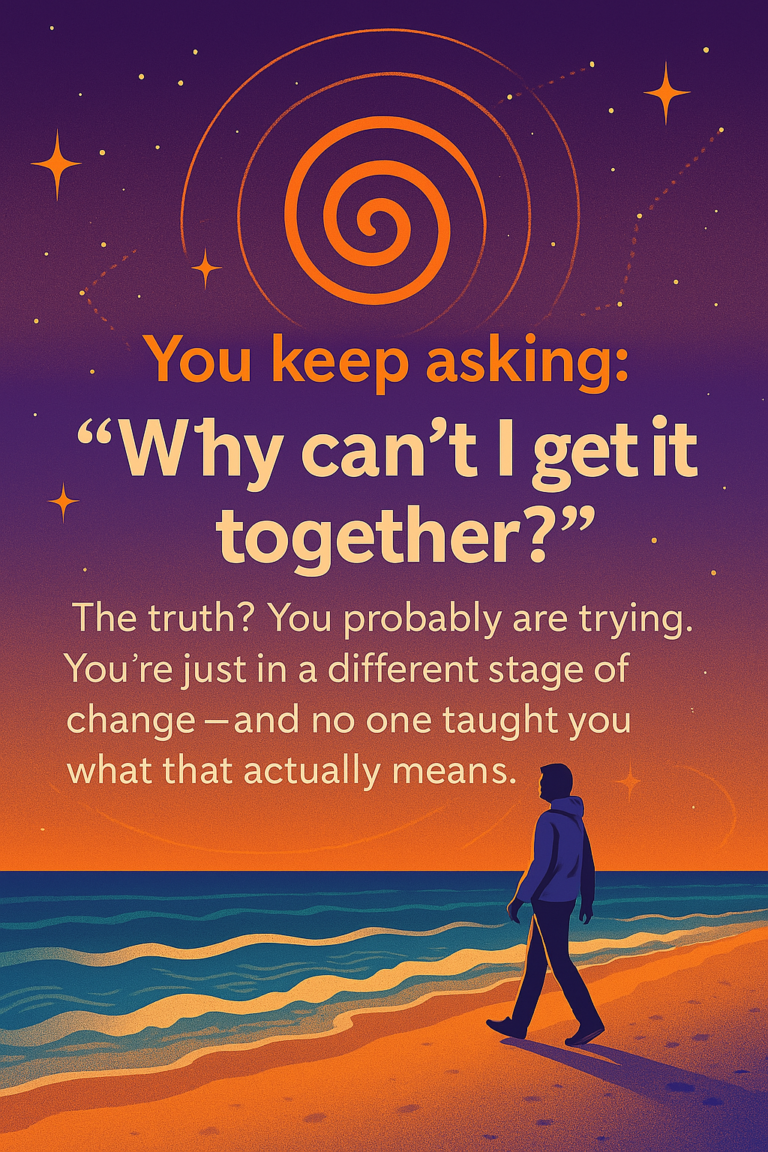Let’s be honest: if saying “I just need to get my sh*t together”* worked, you’d be done by now.
Most of us have tried to change something—our habits, our patterns, how we show up in relationships—and we either push too hard too fast, stall out, or end up right back where we started. It’s not because we’re lazy or broken. It’s because no one ever taught us how real change works.
So here’s the truth:
Change isn’t a motivational high.
It’s not about forcing discipline from thin air.
And it’s definitely not linear.
It’s a cycle. A system. A practice.
And that’s what we’re breaking down here.
This isn’t just another “positive vibes only” blog.
This is your practical, step-by-step guide to sustainable change using the Stages of Change model — a framework backed by research from Prochaska & DiClemente (1983) and used across therapy, recovery, and behavioral science. Whether you’re trying to get your mornings under control, rebuild your confidence, or stop self-sabotaging, this is your roadmap.
What Is Sustainable Change (and Why Most Change Doesn’t Last)
Let’s get one thing straight:
Sustainable change isn’t about trying harder. It’s not about grinding until you break. It’s about moving through a specific process, one stage at a time.
If you skip steps, it doesn’t work.
If you rely only on motivation, it doesn’t last.
If you expect perfection, you’ll burn out.
Sustainable change means developing self-awareness, shifting beliefs, committing to small actions, and planning for real life—not your ideal life. It requires discipline, not just inspiration. It means accepting setbacks as part of the path, not signs of failure (Harvard Health, 2020).
To make change stick, you need more than willpower. You need:
- A realistic plan
- A sense of where you are in the process
- A system of accountability
- And a willingness to get uncomfortable on purpose
That’s what this model is for. It meets you where you are—even if that’s stuck, shut down, or starting over. Especially if it’s starting over.
The Stages of Change (Explained Without the Therapy Speak)
This model maps out how people move through change. Most of us jump in halfway or skip steps entirely—and that’s why things fall apart. Understanding where you are helps you know what comes next and what to stop wasting energy on.
Here’s how the Stages of Change model breaks down in real life. This is the framework we use with clients at Orion when we’re helping them build lives that are actually sustainable—mentally, emotionally, and practically (Center for Motivation and Change).
1. Pre-Contemplation
You’re not thinking about changing. You’re still justifying it.
You might say: “It’s not that bad,” or “This is just how I am.”
🛑 Don’t start with shame.
✅ Do get curious. Ask: What’s the cost of staying here?
You can’t solve a problem you won’t name.
2. Contemplation
You’re aware something’s not working, but you feel overwhelmed or unsure.
You’ve got the “I should probably…” voice in your head, but it doesn’t move your body yet.
🛑 Don’t overthink it to death.
✅ Do talk it out, write it down, name the fear.
Change starts here. Awareness is the spark, not the solution.
3. Preparation
You’re making lists. Looking at your calendar. You’re almost ready to go—but not quite moving.
🛑 Don’t plan a new life.
✅ Do plan one small, specific step. What will you do today?
A vague plan won’t survive a hard day. Be real with yourself.
4. Action
You’re in motion. You’ve started doing the thing—even if it’s awkward or imperfect.
🛑 Don’t wait to feel confident.
✅ Do protect the routines that are working.
This is where structure beats motivation, every time. (Harvard Health)
5. Maintenance
You’ve kept it going. You’ve built some consistency.
Now the goal is to hold what you’ve built.
🛑 Don’t assume momentum will last on its own.
✅ Do build rituals. Make it boring. Boring is stable. Stable is powerful.
(James Clear – Atomic Habits)
6. Relapse
Yeah, this is part of the cycle.
You slipped. You fell off. Something broke your rhythm.
🛑 Don’t call it failure.
✅ Do call it feedback. Ask: What changed? What threw me off? What do I need now?
In recovery science, relapse is normal—and expected (NIDA). In life, it’s the same.
How to Move Through the Stages (For Real)
Awareness → Insight → Action
You start with awareness — noticing the pattern.
You build insight — understanding how it got there.
But the real shift happens in action — doing something different.
Most people get stuck bouncing between insight and overthinking.
Knowing your trauma history won’t organize your desk. Closing the laptop and clearing one pile might.
That’s the pivot. And it’s backed by real clinical work. Research from the American Psychological Association shows that action—not just understanding—is what actually creates change.
Write. It. Down.
Hope is not a strategy. Make the plan real:
- What time will you do it?
- Where will you do it?
- What might stop you?
- What happens when it gets hard?
Build Belief—Before You Feel Ready
Your nervous system listens to your language.
If your self-talk sounds like “I can’t,” “This is too hard,” or “I never follow through,” you’re planting doubt instead of belief.
The research from James Clear shows that behavior builds identity. Every time you act on a small habit, you’re proving to yourself that you can. And over time, that becomes who you are.
Say it:
- “I’m learning how to do hard things.”
- “I don’t need motivation. I need structure.”
- “I don’t have to feel ready. I have to start.”
That belief won’t show up on its own—you build it by doing.
Expect Relapse (and Stop Shaming Yourself for It)
Here’s the deal: you will mess up. You’ll skip the workout, ghost the calendar, self-isolate again. And that’s not a sign of failure—it’s part of the process.
In fact, the National Institute on Drug Abuse (NIDA) names relapse as a normal, expected part of behavior change. It’s not just for addiction recovery. It applies to any transformation that asks you to unlearn survival behaviors and create new patterns.
So when you stumble, ask:
- What pulled me off track?
- What did I need in that moment that I didn’t give myself?
- What part of my plan needs adjusting?
Course correct. Don’t collapse.
Get Accountable (Real Change Needs Witnesses)
Change is hard in isolation. That’s not weakness—it’s reality.
Whether it’s your therapist, a trusted friend, or a note on your fridge reminding you who you want to be, you need something outside yourself to help anchor your commitment.
According to the Center for Motivation and Change, supportive environments and accountability systems can dramatically increase success in sustaining behavioral changes. And no—shame isn’t accountability. Compassionate check-ins are.
Build accountability into your calendar, your routine, and your relationships. Not for perfection—just for support.

Wherever you are right now—it’s okay. You’re not late. You’re not lazy. You’re just in a particular stage.
Change is less about effort and more about alignment.
Less about hype and more about coming back to yourself.
You don’t have to be perfect.
You just have to keep moving.
And if you want someone in your corner while you do? We’re here.
Bibliography
- Prochaska, J. O., & DiClemente, C. C. (1983). Stages and processes of self-change of smoking: Toward an integrative model of change. Journal of Consulting and Clinical Psychology.
Foundational paper outlining the Stages of Change model used across behavioral change and therapy. - Harvard Health Publishing (2020). Why behavior change is hard – and why you should keep trying.
Practical insights on sustainable change, discipline, and motivation. - American Psychological Association. Understanding psychotherapy and how it works.
Breaks down how therapy helps with behavior change and actionable insight. - National Institute on Drug Abuse (NIDA). Principles of Drug Addiction Treatment: A Research-Based Guide.
Recognizes relapse as a natural part of change—insightful for all types of behavior change. - Psychology Tools. Stages of Change Worksheet.
Clear visual breakdown of each stage and how to move through them. - James Clear. Atomic Habits.
Actionable framework for building and maintaining habits through identity, environment, and small wins. - Center for Motivation and Change. Stages of Change.
A compassionate, user-friendly breakdown of the model with a focus on self-compassion and accountability.





